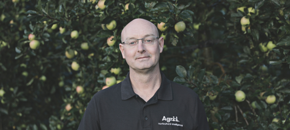The Ripening Story of British Blackcurrants in a Changing Climate
Live on Farm
Field to Factory: Blackcurrant Agronomy and Harvest at West End Farm
Live from Tramlines - A Podcast by Agrii
In this special live episode of Tramlines, Agrii visits West End Farm in Somerset, home to R.J. Morris, during the heart of blackcurrant harvest.
Host Tony Smith is joined by Harriet Prosser, Agronomist for Ribena, and Matt Greep, Fruit and Horticultural Agronomist at Agrii, to explore how this iconic British crop is grown, protected, and futureproofed.
This Episode Features:

Tony Smith
Your Tramlines Host

Matt Greep
Agrii Agronomist & Area Business Manager, Fruit Crops

Harriet Prosser
Agronomist, Ribena
The Legacy of Blackcurrants in the UK
Blackcurrants have a deep-rooted place in British agriculture. As Harriet explains, Ribena was originally developed in 1938 by Dr Vernon Charley to provide a local source of vitamin C during wartime shortages. Since then, a nationwide network of growers has been established to meet the brand’s seasonal demand.
Regional and Varietal Resilience
Why Crop Spread Matters
To ensure a continuous six-week harvest window, growers use a combination of:
- Early, mid, and late-ripening blackcurrant varieties
- A regional spread from Dundee to East Anglia and Somerset
This approach mitigates localised weather risks such as frost or drought and maintains a steady flow of fruit to processors.
Managing Key Pests: The Blackcurrant Gall Mite
The blackcurrant gall mite remains the most challenging pest in blackcurrant production. As Matt explains, it overwinter in buds and emerges in a narrow window, requiring precise monitoring and timed applications.
Using variety Ben Gairn, resistant to reversion virus (spread by gall mite), is one example of integrating genetics into pest management strategies.
Establishing New Blackcurrant Crops
From Hardwood Cutting to Harvest
New blackcurrants are planted from hardwood cuttings in late winter. While the first year focuses on root and vegetative growth, the plants are cut back at the end of the season to encourage robust framework and root anchoring, essential for machine harvesting in years two and three.
By year three, a small harvest can begin with expectations of around 7–8 tonnes per hectare under good conditions.
The Importance of Soil Health
Soil structure and nutrient availability are crucial. Agrii works with growers to:
- Assess nutrient levels through soil testing
- Unlock bound nutrients like phosphorus using and improved nutrient strategies
- Adapt nutrient inputs for perennial fruiting systems
Weather Resilience and Crop Management
With rising summer temperatures and changing weather patterns, blackcurrant bushes must cope with stress during key growth stages. Matt discusses using:
- Biostimulants and amino acid foliar feeds to support leaf quality and root strength
- Managing canopy architecture to offer natural shading for berries
These practices help maintain fruit quality and minimise drought stress.
Variety Breeding for Climate Adaptation
Ribena has been breeding new blackcurrant varieties for over 25 years, working with the James Hutton Institute in Dundee. Selection focuses on:
- Drought resilience
- Lower winter chill requirements
- Consistency of yield and fruit quality
Recent varieties like Ben Lawers and Ben Macdui are showing strong performance under drought conditions named, of course, after Scottish mountains!
Harvesting: From Field to Factory
How It Works
Harvesters straddle the row, shake berries from the bush, and blow away debris before collecting them in bins. Fruit is delivered to processors within 24–48 hours to preserve freshness and quality.
Attention to Detail
Every crate is checked for leaf, twig or snail contamination. Growers even manage alleyways using functional mixes (e.g., yarrow or wildflowers) to deter pests and support natural IPM (Integrated Pest Management).
Soil, Alleyways and Biodiversity
Alleyways – often overlooked – are now seen as an untapped asset. They can support soil biology, promote beneficial insects, and suppress pest populations when managed strategically.
Agrii and Ribena collaborate on a six-point biodiversity plan including:
- Hedgerow management
- Provision of nest boxes
- Tree planting and pollinator habitats
Final Thoughts from the Field
With yields expected to reach up to 8 tonnes/ha, the team at West End Farm remains focused on both performance and longevity of the plantation. Harriet highlights the importance of balancing harvest with next year’s crop health through root preservation and canopy care.
Takeaway Tips from Our Agronomists
Matt Greep’s Top Tip:
“Anticipate stress. Don't wait for it. Use biostimulants and foliar support proactively to help crops stay functional through extreme conditions.”
Harriet Prosser’s Advice:
“Stay close to your customer and your grower network. Communication and trust allow us to overcome seasonal challenges together.”
To find out more about Agrii's fruit offering please visit our Specialist Fruit section
Related episodes
Feeding the Roots
Episode 11Rooted in Nutrition: Soil Health and Smarter Inputs
Episode 4Seed Success: Understanding Treatments, Science & Innovation
Episode 20The Reality of SFI: Part 2 - The What, Where and How?
Episode 19Smart Nutrition: Maximising ROI on Phosphate, Potash & Nitrogen
Episode 18Carbon Trading - The Reality
Episode 12Integrated Pest Management and Beneficial Insects
Episode 11Focusing on Phosphate with Agrii's Nutrition Specialists
Episode 9Branching Out With Top Fruit Nutrition
Episode 8Never miss an episode of Tramlines








